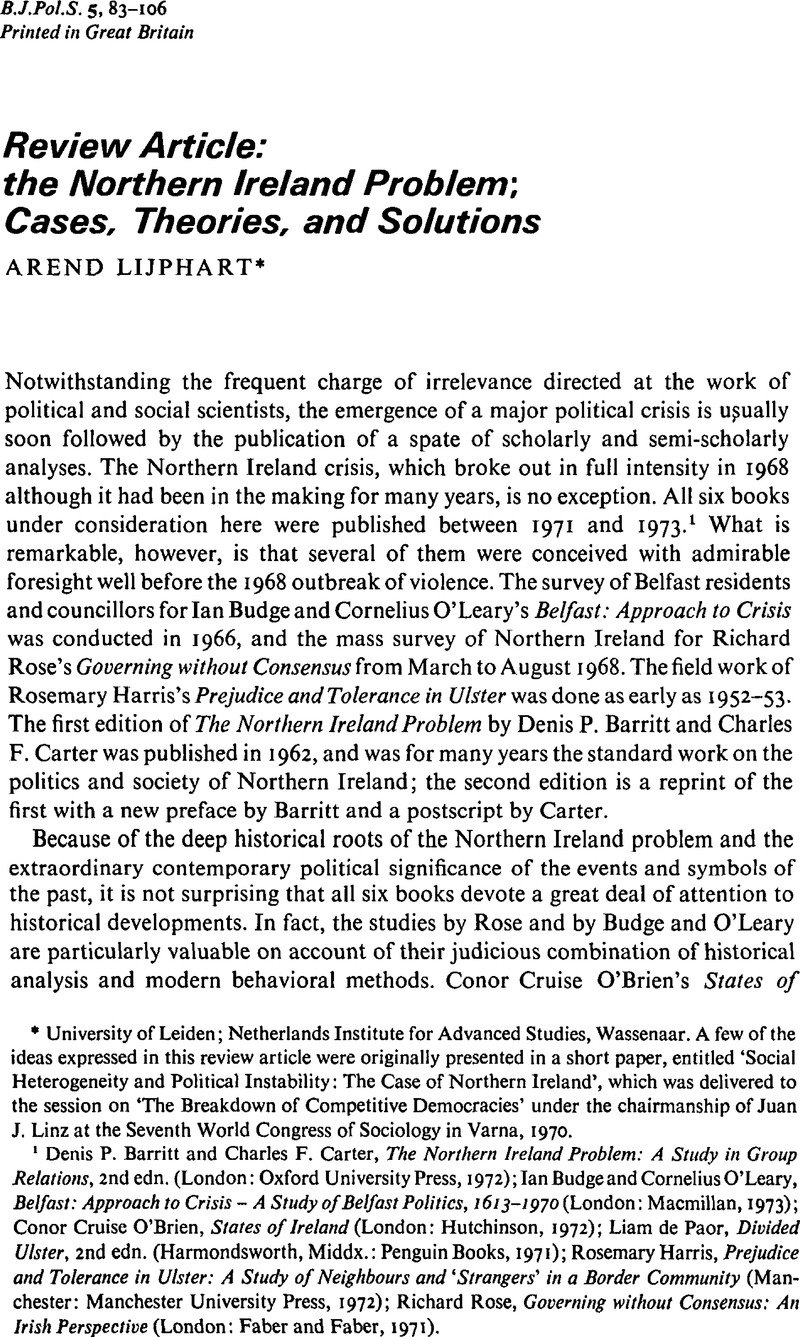Published online by Cambridge University Press: 27 January 2009

1 Barritt, Denis P. and Carter, Charles F., The Northern Ireland Problem: A Study in Group Relations, 2nd edn. (London: Oxford University Press, 1972)Google Scholar; Budge, Ian and O'leary, Cornelius, Belfast: Approach to Crisis — A Study of Belfast Politics, 1613–1970 (London: Macmillan, 1973)Google ScholarO'brien, Conor Cruise, States of Ireland (London: Hutchinson, 1972)Google Scholar; De Paor, Liam, Divided Ulster, 2nd edn. (Harmondsworth, Middx.: Penguin Books, 1971)Google Scholar; Harris, Rosemary, Prejudice and Tolerance in Ulster: A Study of Neighbours and ‘Strangers’ in a Border Community (Manchester: Manchester University Press, 1972)Google Scholar; Rose, Richard, Governing without Consensus: An Irish Perspective (London: Faber and Faber, 1971).Google Scholar
2 Rokkan, Stein, Citizens, Elections, Parties: Approaches to the Comparative Study of the Processes of Development (Oslo: Universitetsforlaget, 1970), p. 49.Google Scholar
3 The index of religious voting is here defined as the percentage of Protestants supporting the Unionists minus the percentage of Catholics supporting the Unionists, among respondents expressing a preference for the Unionists, the Nationalists, or the Northern Ireland Labour Party. Based on somewhat earlier surveys, the indices of religious voting in a few other countries with heterogeneous Protestant-Catholic populations areas follows: United States, +16; Great Britain, +7; West Germany, +29; The Netherlands, +50; Switzerland, +59; Australia, +14; and Canada, +21. See Alford, Robert R., Party and Society: the Anglo-American Democracies (Chicago: Rand McNally, 1963), p. 91Google Scholar; and Lijphart, Arend, Class Voting and Religious Voting in the European Democracies: a Preliminary Report, Occasional Paper No. 8 (Glasgow: Survey Research Centre, University of Strathclyde, 1971), pp. 8–9.Google Scholar
4 In one place, Rose suggests a mixture of the first two perspectives as the correct interpretation: ‘Because Catholics see discord in nationality terms whereas Protestants see it in religious terms, politics in Northern Ireland involves ideologically unrelated conflicts’ (p. 216).
5 See Smith, M. G., ‘Some Developments in the Analytic Framework of Pluralism’, in Kuper, Leo and Smith, M.g., eds., Pluralism in Africa (Berkeley: University of California Press, 1969), pp. 415–18.Google Scholar
6 Almond, Gabriel A., ‘Comparative Political Systems’, Journal of Politics, XVIII (1956), 391–409.CrossRefGoogle Scholar
7 A considerable problem in this connection is that the term ‘culture’ can be defined in divergent ways. O'Brien, for example, speaks of the ‘cultural separateness’ of the religious groups in a sense that it is quite distinct from political attitudes (p. 15).
8 Hartz, Louis, The Founding of New Societies: Studies in the History of the United States, Latin America, South Africa, Canada and Australia (New York: Harcourt, Brace and World, 1964), p. 3.Google Scholar
9 The exact definition is: ‘the sum of the differences between the proportions of each religion giving a particular response [divided] by two’ (pp. 200–1).
10 Juan J. Linz, ‘The Breakdown of Democratic Politics’ (paper delivered at the Seventh World Congress of the International Sociological Association in Varna, 1970).
11 Duverger, Maurice, ‘The Development of Democracy in France’, in Ehrmann, Henry W., ed., Democracy in a Changing Society (New York: Praeger, 1964), p. 77.Google Scholar
12 Eckstein, Harry, Division and Cohesion in Democracy: A Study of Norway (Princeton. N.J.: Princeton University Press, 1966), p. 234.Google Scholar
13 In order to measure the levels of cross-cutting, Rae and Taylor's index XC was used. See Rae, Douglas W. and Taylor, Michael, The Analysis of Political Cleavages (New Haven: Yale University Press, 1970), pp. 85–113.Google Scholar
14 See Lijphart, , ‘Consociational Democracy’, World Politics, XXI (1969), 207–25.CrossRefGoogle Scholar
15 Linz, ‘The Breakdown of Democratic Polities’.
16 See, for instance, Rosenau, James N., ed., Linkage Politics: Essays on the Convergence of National and International Systems (New York: Free Press, 1969).Google Scholar
17 Carter's, suggestion is not fully consociational, because instead of accepting the religiously based parties as the main partners in elite accommodation, he prefers ‘a quite new and non-sectarian structure of parties’ (p. 167).Google Scholar